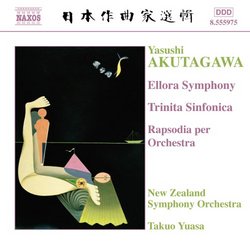| All Artists: Yasushi Akutagawa, Takuo Yuasa, New Zealand Symphony Orchestra Title: Yasushi Akutagawa: Ellora Symphony; Trinita Sinfonica Rapsodia per Orchestra Members Wishing: 0 Total Copies: 0 Label: Naxos Release Date: 5/17/2005 Genre: Classical Style: Symphonies Number of Discs: 1 SwapaCD Credits: 1 UPC: 747313597529 |
Search - Yasushi Akutagawa, Takuo Yuasa, New Zealand Symphony Orchestra :: Yasushi Akutagawa: Ellora Symphony; Trinita Sinfonica Rapsodia per Orchestra
 | Yasushi Akutagawa, Takuo Yuasa, New Zealand Symphony Orchestra Yasushi Akutagawa: Ellora Symphony; Trinita Sinfonica Rapsodia per Orchestra Genre: Classical
|
Larger Image |
CD Details |
CD ReviewsWow! Erik Homenick | San Diego, California | 10/29/2005 (5 out of 5 stars) "This disc is simply amazing. Well worth the (incredibly low) price for the ELLORA SYMPHONY alone, Yasushi Akutagawa's musical art will leave you absolutely floored. Akutagawa-sensei was a student of Akira Ifukube, and that influence certainly shows in every piece on this recording. The ELLORA SYMPHONY was inspired after a trip the composer took to the town of Ellora in India; it is a violently modern symphonic depiction of the sexually explicit cave art he encountered in that region. The rhythmic ostinato and explosive percussion will give any good sound system a run for its money and will leave the listener breathless, agitated and astounded. Highly recommended." "It is the stretched soul that makes music, and souls are st Crazy Fox | Chicago, IL USA | 05/23/2008 (5 out of 5 stars) "Japan's contribution to classical music has been gradually rescued from utter obscurity this side of the Pacific by Naxos and their excellent series devoted to Japanese composers. This CD, a relatively earlier offering from the series, features the same high quality recording of command performances as the others and showcases the compositions of Akutagawa Yasushi (1925-1989), a fairly popular and well-known cultural figure in postwar Japan (even appearing in Nestle TV ads, of all things) and, in case you're wondering, yes, youngest son of the author Akutagawa Ryunosuke. Akutagawa Yasushi's music can be divided into three distinct creative phases, and this CD includes one key work from each phase, making it an eminently representative encapsulation of a key composer's lifework.
Somewhat inconveniently, the three selections run in backwards chronological order, so that the last one, "Trinita Sinfonica" (1948) is the earliest. Also the most accessible in its sheer musical beauty, this piece still displays the deep influence of Akutagawa's mentors Hashimoto and Ifukube yet in an odd alchemical mix all his own--at once peacefully and harmoniously lyrical and yet stridently and sweepingly dynamic. Passive Yin and active Yang in a carefully balanced dance. The "Ellora Symphony" of 1958 is the very antithesis of this, as if Akutagawa did a musical 180: jarring, fragmentary, atonal, very late 20th-century. And yet this dissonant symphony is strangely meditative nonetheless, suffused with an eerily passionate mysticism inspired by the Ellora cave temples of India with their mix of Buddhist, Hindu, and Jain sculptures both voluptuous and ascetic. And with its blend of slow "feminine" and fast "masculine" movements it evinces assured continuity with Akutagawa's earlier work. The final piece and first track, 1971's "Rapsodia per Orchestra" brings all of these diverse and even paradoxical strands into a grand synthesis. Accessibly avant-garde, lyrically dynamic and yet full of harshly disharmonious shocks, this dramatic rhapsody seems to accomplish the impossible even as it underlines Akutagawa's stance that fine music is for everyone. The liner notes for this tripartite CD are generously extensive as is dependably standard for Naxos, and they do a capable job of introducing the composer and his musical career as well as describing the date and occasion of each selection and analyzing it in painstakingly precise musicological detail. Some of the latter will doubtlessly be a bit above the average amateur listener such as myself, but one can always skim, and the serious classical enthusiast and music lover will find the discussion on a level of sophistication commensurate with their dedicated interest. Which is as it should be with a CD and a classical composer of this caliber. In any case, sit back with your earphones and prepare for the trip of a creative lifetime. P.S. For Akutagawa's mentors, see Hashimoto: Symphony No. 1 in D; Heavenly Maiden and Fisherman and Ifukube: Sinfonia Tapkaara. For his friend and colleague perhaps somewhat influencing his second phase, see Toshiro Mayuzumi: Mandala Symphony; Bugaku; Symphonic Mood; Rumba Rhapsody." |

 Track Listings (20) - Disc #1
Track Listings (20) - Disc #1